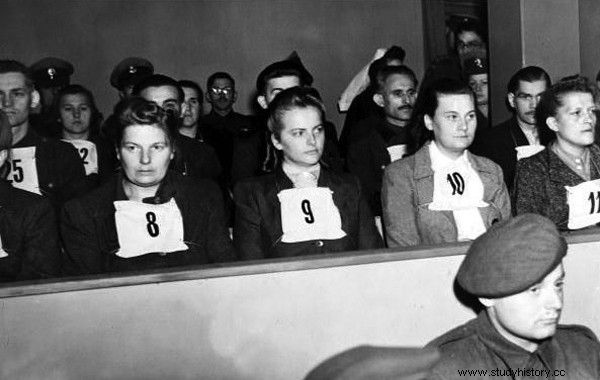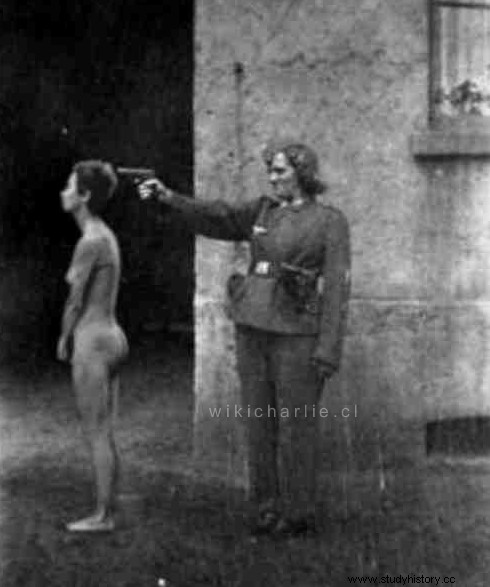Irma Grese was a young German volunteer, militant in the Nazi Party, who, from 1942 to 1945, worked in various concentration camps, as a prison guard, supervisor and director of prisoners' works.
Irma Grese has been renamed in various fields as Aushwitz's Hyena and Belsen's Blonde Beast She In Nuremberg she has been described as a cruel and sadistic woman, but I personally believe that she Irma was not really cruel.
I believe instead that she was a victim, in a different way, of the Nazi regime. Growing up shrouded in hatred, she found herself guarding those who had always been told as demons, at the age of just 19, she was also surrounded by violent and cruel men and women, who would have sent her away if had not been up to par. Irma was then forced by society to become a beast that she really wasn't her.
In fact, her story about her tells us about a woman who wanted to become a nurse, who wanted to help people, but she found herself destroying them.
The story of Irma Grese
The image on the left depicts a group of women, tried during the Nuremberg trials, in one of the twelve minor trials.

The woman in the center of the photo, number 9, is Irma Grese, of whom we can see a photo taken between 1943 and 45 while she was engaged as a volunteer guard at a concentration camp.
I'm researching the story of this woman, I leave you at the end of the article some of the books I'm reading, and the horrors it produced, were terrifying, Irma was known in various fields with different nicknames including The Blonde Beast of Belsen and The hyena of Auschwitz .
During the trials she was described as a cruel, violent woman who took pleasure and found fulfillment in the sufferings of the prisoners.
Irma Grese has become, for many, one of the symbols of Nazi cruelty, but her story reveals something else. really such a sadistic woman?
The youth of Irma Grese
Reading her biography we discover that Irma was the daughter of Adolf Grese , moderate militant of the Nazi party, and who from a very young age took part in the League of German Girls (Association of National Socialist inspiration) according to historians, her father disapproved of the choice, even if, from 1937 he became an employee of the NSDAP.
The following year, at the age of 15, Irma Grese started working in a hospital and tried to become a nurse, but without success, according to Irma's statements at the Nuremberg Nuremberg trials, due to the will of the Labor Committee that instead he assigned it to a dairy in Fürstenberg .
The young woman wanted to become a nurse, but she was sent to make cheese, so she decided to try another path and in 1942 she tried again to become a nurse.
This time the application was accepted and the woman was sent as a nurse to the Ravensbrück concentration camp , where, according to the testimonies and the documentation received at the Nuremberg trials, it seems that Irma did not want to stay and asked for a transfer several times.
The move eventually came, in 1943, but not as desired.
Guard work in concentration camps
During the year she was in Ravensbrück, Irma had attended a training course as a prison guard at the end of which she was sent to Auschwitz as aufseherin .
At the end of 43, Irma was promoted to Senior Supervisor of Auschwitz and under her control there were about 33,000 Jewish women.
The cruel management of the camp led to Irma a promotion, and between January and February 45 she was transferred back to Ravensbrück, according to statements and official sources, to train the new guards she, then in March of the same year she was sent to the camp of Bergen-Belsen as a new “ Director of Works “.

The direction of the works of the Bergen-Belsen prisoners was the last assignment of Irma Grese who, on April 17, 1945 she was captured by the British army during the liberation of the camp.
Irma was one of the few officers who could not escape the camp, or perhaps she was one of the officers who were sacrificed to allow others to escape.
Who was Irma Grese really?
Irma's story tells us of a lethal devotion to the NSDAP, Irma was so devoted to the party that she gave up her dream of becoming a nurse, to become a prison guard, she went from wanting to save lives to destroying them.
During the trial of Jerusalem of Adolf Eichmann , the name of Irma Grese appeared several times, and between the two Nazis a strong parallel was drawn, the man and the woman had both been plagiarized by the party, and if they weren't really cruel or evil or demonic , performed inhumane actions , because, as Hannah Arendt observes , in the Banality of Evil, absolutely unable to really put themselves in other people's shoes.
For Irma the prisoners of the camps were not men and women, but enemies of everything she believed in, Irma was firmly convinced that all the pain and suffering of her people was the responsibility of those people who, secretly, in the shadows, conspired to take away from them, home and work.
Irma in lei, when she started working in the Ravensbrück camp she was only 19, and at 20 she was responsible for controlling more than 30,000 prisoners.
Come canta Francesco Guccini "a 20 anni si è stupidi davvero, quante balle si ha intesta a quell'età" ed Irma, quando divenne guardia carceraria nel campo di Ravensbrück, aveva proprio 20 anni.
Personal considerations on Irma Grese
When Irma Grese, Belsen's blond beast, the Auschwitz hyena, was captured in 1945, she was only 23.
The story, through the Nuremberg trials has told this woman as a monster and the actions she did, were actually monstrous and cruel, but they were performed by what was little more than a girl, plagiarized by a system of values that, since when she was a child, at the age of 10, in 1933 when Hitler took power, he had always told her that those people, Jews and all those who were not Germans, were evil and dangerous.
Irma grew up wrapped in hatred and that hatred of her made her a monster, despite her desire to help and save lives.
Irma was convinced, during her voluntary service in the various concentration camps, that she was doing the right thing, that she was helping her people, her country and fighting the enemies of her nation, without however realizing that those she tortured daily, because torture is spoken of (and there are many testimonies in the Nuremberg acts) they were women like her, with one difference, on paper they weren't German and for this reason everything had been taken away from them, their home, work, family, name, humanity had been taken away.
Irma Grese, working for the Reich, believed she was fighting a conspiracy, without realizing that she was part of the conspiracy carried out by a handful of ambitious and truly cruel men, whose power was based on hatred.
Recommended bibliography
D. Cesarani, Adolf Eichman
D. Lipstadt, The Eichmann Process
H. Arendt, The banality of Evil
H. Arendt, J.Fest, Eichmann or the banality of evil, interview, letters, documents
R.Jennings, Irma Grese &Auschwitz:Holocaust and the Secrets of the The Blonde Beast
S.T. McRae, Irma Grese:A True Account of the Holocaust's Deadliest Woman
S.Helm, If This Is A Woman:Inside Ravensbruck:Hitler's Concentration Camp for Women
